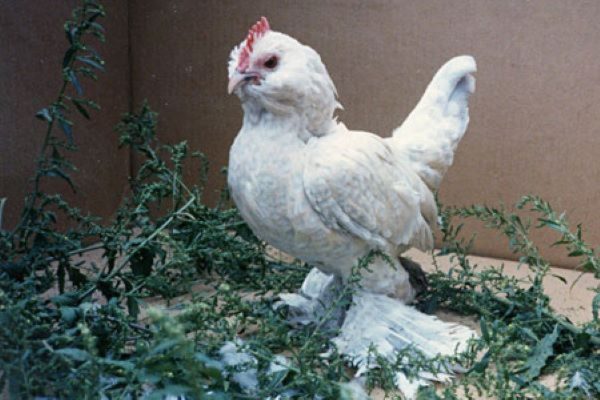
Nearly every chicken breed has a bantam version. But some bantam breeds have no larger counterpart. The latter are true bantams. Cackle Hatchery® offers the following true bantam chicken breeds:
Belgian d’Anvers
Belgian d’Anvers bantams get their name from the Belgian municipality of Antwerp, which is “Anvers” to the French. The word d’Anvers therefore means “from Anvers/Antwerp.” Other names for this breed are Antwerp Belgian and Bearded d’Anvers.
This true bantam comes in a number of different color varieties. It has a rose comb, small or no wattles, a full beard, and muffs that cover the earlobes. The hens lay small eggs with white shells and tend to go broody.
Belgian d’Uccle
Belgian d’Uccle bantams get their name from the Belgian town of Uccle. They came about by crossing Belgian d’Anvers with Booted Bantams (another true bantam breed). The goal was to achieve a bantam with both a beard and leg feathers, or boots. Another name for this breed is Bearded d’Uccle.
Like the d’Anvers, this true bantam comes in several color varieties. It has a single comb, small or no wattles, a full beard and muffs, and fully feathered legs with vulture hocks. The hens lay small eggs with white shells, and they readily brood.
Japanese Bantam
The Japanese bantam is an ancient breed originating in Japan. This true bantam has a large tail in proportion to its size. A Japanese rooster carries this outsize tail so far forward that the feathers nearly touch the back of his head.
Other features include a large single comb and long drooping wings. The Standard calls for unusually short legs, which are associated with the lethal creeper gene.
These little birds, which come in several color patterns, are highly capable fliers. The hens lay eggs with brown shells and make excellent broodies.
Rosecomb
The Rosecomb is an old breed of true bantam originating in England as a gorgeous ornamental chicken. It is named for its prominent bright-red rose comb. The Rosecomb bantam has white earlobes and a full tail that’s large in relation to its small, compact body, and it comes in numerous color varieties.
Rosecomb eggs tend to be low in fertility, as is common among breeds having a rose comb. The chicks that do hatch are extremely delicate, requiring extra care to raise. But once they reach maturity these bantams are hardy and active, as well as being capable fliers. The hens are rather poor layers of eggs with tinted shells, and seldom brood.
Sebright
The Sebright is another old breed of true bantam from England, the creation of Sir John Sebright. These bantams are unique among chickens in being hen feathered, which means the roosters, like hens, have rounded hackle and saddle feathers. Sebrights come in two color patterns, both laced — silver and golden.
Sebrights have a rose comb and, like Rosecomb bantams, their eggs tend to be low in fertility. And, similarly, the chicks are tiny and delicate, and so require extra care. But mature Sebrights are hardy, active, and capable fliers. The hens tend to be poor layers of small eggs with white shells. And they seldom brood.
Silkie
Most likely the Silkie was originally from China, although it sometimes goes by the name of Japanese Silkie. Whether or not it is a true bantam chicken is a matter of some contention. Although backyard Silkies in the United States are often promoted as true bantams and are bred to weigh no more than three pounds, at ethnic Chinese markets you can find Silkies that weigh four pounds or more.
The breed name refers to this chickens’ fluffy, furlike plumage. These birds have a crest, a walnut comb, turquoise earlobes, leg feathers, and five toes (some have six). The skin and shanks are black, and the face, comb, and wattles are dark purple. They may be either bearded or nonbearded, and come in several color varieties, the most common ones being white and black.
Silkies are popular bantams because they are super friendly and they can’t fly. The hens are decent layers of small, tinted eggs. They are such good setters that many chicken keepers have them solely for incubating the eggs of rare or nonbrooding poultry.
And that’s today’s news from the Cackle Coop.
Gail Damerow has authored numerous books about poultry, including The Chicken Encyclopedia.

